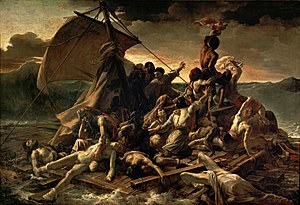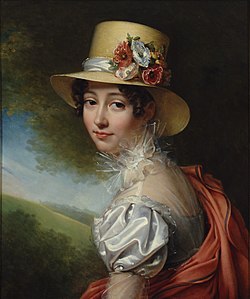| Revision as of 06:51, 19 January 2025 editEst. 2021 (talk | contribs)Extended confirmed users, Pending changes reviewers14,557 editsm cleanup via script | fixed dashes using User:Ohconfucius/dashes.js← Previous edit | Latest revision as of 00:42, 21 January 2025 edit undoLord Cornwallis (talk | contribs)Autopatrolled, Extended confirmed users, Pending changes reviewers460,838 edits →Gallery | ||
| Line 25: | Line 25: | ||
| File:Attack on a large convoy at Salinas.jpg|'']'' by ] | File:Attack on a large convoy at Salinas.jpg|'']'' by ] | ||
| File:Angoulême at Pauillac.png|'']'' by ] | File:Angoulême at Pauillac.png|'']'' by ] | ||
| File:Louisantoined'artoisducdangouleme.jpg|''Portrait of the ]'' by ] | |||
| </gallery> | </gallery> | ||
Latest revision as of 00:42, 21 January 2025
1819 art exhibition in Paris
The Salon of 1819 was an art exhibition held at the Louvre in Paris between 25 August and 30 September 1819. It was the largest Salon to be staged since the fall of Napoleon. It took place during the Restoration era with Louis XVIII on the throne. It was the first to be held since the withdrawal of Allied Occupation forces from the country at the end of the previous year. The two officials behind the exhibition the Count Forbin and Vicomte de Senonnes set out to make it even more a celebration of the House of Bourbon that the previous Salon of 1817.
More than thirteen hundred paintings were displayed at the Salon. Over a hundred paintings were in the then fashionable Troubadour style including Roger Freeing Angelica by Jean-Auguste-Dominique Ingres. Alexander the Great Visiting Apelles by Marie Nicolas Ponce-Camus was rejected from submission as the jury believed it alluded to a visit Napoleon had made to the studio of Jacques-Louis David during the Hundred Days. By contrast Horace Vernet's Massacre of the Mamelukes, taken to be a covert reference to the White Terror against Napoleon's supporters, was allowed to be displayed. Vernet exhibited a number of works at the Salon including The Dog of the Regiment Wounded.
Louis Hersent produced a popular history painting Gustave Vasa. Amongst others who exhibited was the rising star Ary Scheffer. The standout work was The Raft of the Medusa by Théodore Géricault depicting the shipwreck of the frigate Medusa.
Gallery
-
 Portrait of Zoé Jacqueline Duvidal de Montferrier by Julie Hugo
Portrait of Zoé Jacqueline Duvidal de Montferrier by Julie Hugo
-
Domenichino by Julie Charpentier
-
 Pygmalion and Galatea by Girodet
Pygmalion and Galatea by Girodet
-
 Massacre of the Mamelukes by Horace Vernet
Massacre of the Mamelukes by Horace Vernet
-
 Portrait of François de Charette by Jean-Baptiste Paulin Guérin
Portrait of François de Charette by Jean-Baptiste Paulin Guérin
-
 Alexandrine Jolly by Jean-Baptiste Paulin Guérin
Alexandrine Jolly by Jean-Baptiste Paulin Guérin
-
 Portrait of the Duchess of Angoulême by Louise Bouteiller
Portrait of the Duchess of Angoulême by Louise Bouteiller
-
 The Dream of Happiness by Pierre-Paul Prud'hon
The Dream of Happiness by Pierre-Paul Prud'hon
-
 Joan of Arc Imprisoned in Rouen by Pierre Révoil
Joan of Arc Imprisoned in Rouen by Pierre Révoil
-
 Mary, Queen of Scots in her Cell by Philippe-Jacques van Bree
Mary, Queen of Scots in her Cell by Philippe-Jacques van Bree
-
 Entrance to the Ambigu-Comique Theatre by Louis-Léopold Boilly
Entrance to the Ambigu-Comique Theatre by Louis-Léopold Boilly
-
 Roger Freeing Angelica by Jean-Auguste-Dominique Ingres
Roger Freeing Angelica by Jean-Auguste-Dominique Ingres
-
 Attack on a large convoy at Salinas by Louis-François Lejeune
Attack on a large convoy at Salinas by Louis-François Lejeune
-
 The Embarkation of the Duchess of Angoulême at Pauillac by Antoine-Jean Gros
The Embarkation of the Duchess of Angoulême at Pauillac by Antoine-Jean Gros
-
 Portrait of the Duke of Angoulême by François Kinson
Portrait of the Duke of Angoulême by François Kinson
References
- Boime p.145
- Boime p.145
- Harkett & Hornstein p.155
- Boime p.145
- Boime p.145-46
- Boime p.145
- Spitzer p.31
- Miles p.178
Bibliography
- Boime, Albert. Art in an Age of Counterrevolution, 1815–1848. University of Chicago Press, 2004.
- Harkett, Daniel & Hornstein, Katie (ed.) Horace Vernet and the Thresholds of Nineteenth-Century Visual Culture. Dartmouth College Press, 2017.
- Miles, Jonathan. Medusa: The Shipwreck, the Scandal, the Masterpiece. Random House, 2008.
- Noon, Patrick & Bann, Stephen. Constable to Delacroix: British Art and the French Romantics. Tate, 2003.
- Spitzer, Alan Barrie. The French Generation of 1820. Princeton University Press, 2014.